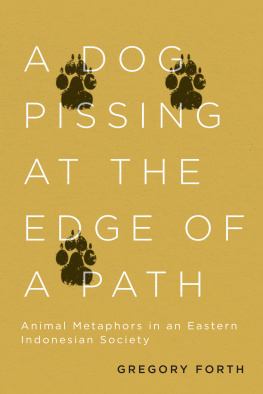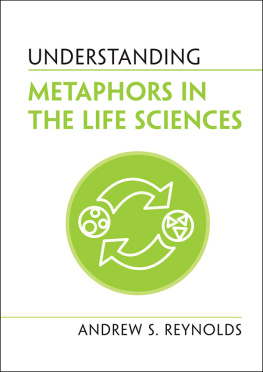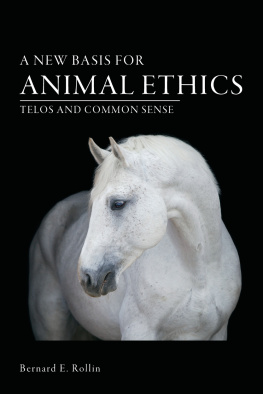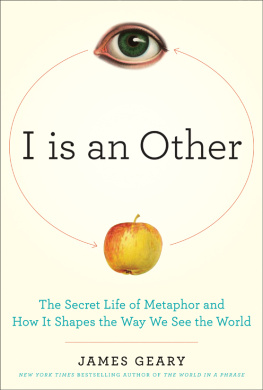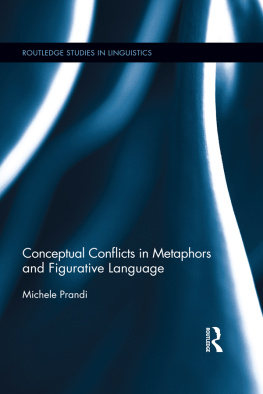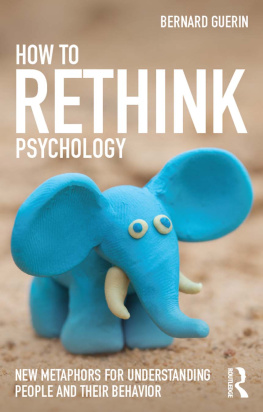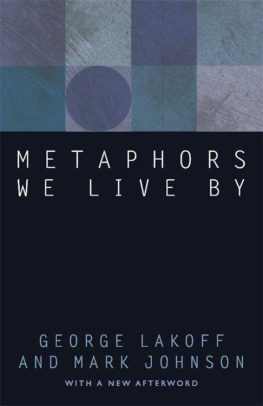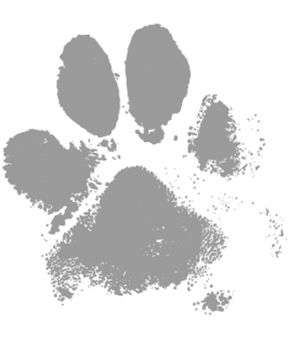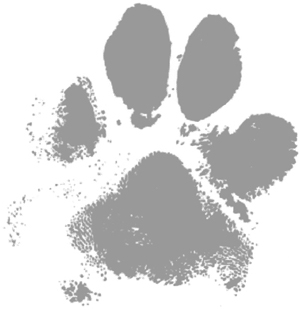
A DOG PISSING AT THE EDGE OF A PATH
GREGORY FORTH
A DOG PISSING AT THE EDGE OF A PATH
Animal Metaphors in an Eastern Indonesian Society
McGill-Queens University Press
Montreal & Kingston London Chicago
McGill-Queens University Press 2019
ISBN 978-0-7735-5922-6 (cloth)
ISBN 978-0-7735-5923-3 (paper)
ISBN 978-0-2280-0004-4 (ePDF)
ISBN 978-0-2280-0005-1 (ePUB)
Legal deposit fourth quarter 2019
Bibliothque nationale du Qubec
Printed in Canada on acid-free paper that is 100% ancient forest free
(100% post-consumer recycled), processed chlorine free
We acknowledge the support of the Canada Council for the Arts.
Nous remercions le Conseil des arts du Canada de son soutien.
Library and Archives Canada Cataloguing in Publication
Title: A dog pissing at the edge of a path : animal metaphors in an eastern Indonesian society / Gregory Forth.
Names: Forth, Gregory, author.
Description: Includes bibliographical references and index.
Identifiers: Canadiana (print) 20190171820 | Canadiana (ebook) 20190171944 | ISBN 9780773559226 (cloth) | ISBN 9780773559233 (paper) | ISBN 9780228000044 (ePDF) | ISBN 9780228000051 (ePUB)
Subjects: LCSH: MetaphorSocial aspectsIndonesiaFlores Island. | LCSH: AnimalsSocial aspectsIndonesiaFlores Island. | LCSH: Human-animal relationshipsIndonesiaFlores Island. | LCSH: Nage (Indonesian people)Social life and customs. | LCSH: Nage (Indonesian people)EthnozoologyIndonesiaFlores Island.
Classification: LCC P301.5.M48 F67 2019 | DDC 306.442/99221dc23
For my wife, Christine
Contents
Figures and Tables
Figures
All photographs taken by author unless otherwise specified.
Tables
Preface
This book started off as a remnant of another (Forth 2016). When some years ago I began writing a monograph on the folk zoology of the Nage people of eastern Indonesia the various kinds of knowledge they possessed concerning non-human animals I planned to include a comprehensive coverage of animal metaphors. However, it soon became apparent that Nage animal metaphors were far too numerous to treat adequately in that volume, and that a separate book would be in order. Especially from further field research conducted between 2014 and 2018, I also realized that I had rather more to say about how Nage understood metaphor and about the concept of metaphor in general. More particularly, it became clear that the Nage regard standard (or conventional) animal metaphors, including the majority that use animals to talk about humans and human behaviours, ultimately as fictions. That is, they recognize that a person spoken of as a dog pissing at the edge of a path, say, is not really a dog nor, by virtue of certain actions, has she or he temporarily become a dog. And conversely, they know that using dogs and other animals to speak about humans the fact that humans and animals can be brought together in this manner does not mean that these creatures are in some essential sense human.
Expressed another way, people in this small-scale eastern Indonesian community of cultivators, hunters, and raisers of livestock understand their metaphors in much the same way as Westerners understand theirs as special ways of speaking and not as articulations of radically different ways of experiencing the world. In fact, many Nage metaphors are closely comparable to animal metaphors found in English, if not always in regard to the animals employed, then in specific animal behaviours or interpretations recognized by their users a finding that should attract the attention of anyone interested in human cognition and human universals. Readers will thus discover, for example, that both in English and in the language of a small eastern Indonesian island, muscles are referred to with words that ultimately mean mouse; that duplicity is conveyed by an animal (the monitor lizard) with a forked tongue; that the straight tail of a civet stands for honesty; and that the dog metaphor from which this book takes its title is closely comparable to the anglophone expression to piss about.
To many readers, or at least many of those who are not anthropologists, this finding may not come as much of a surprise. However, in recent years a number of anthropologists have advanced a view of metaphor as a peculiarly Western concept that many of their colleagues have unwittingly imposed on their ethnographic subjects. What is more, writers who have been described as ontological pluralists (discussed at some length in ) have argued that non-Westerners or some ill-defined portion of them understand the contrast of human and animal in a fundamentally different way from modern Westerners. It has further been suggested that such people do not possess animal metaphors, at least not in the sense this term is understood in reference to English (or European language) usage. My aim in this book is to demonstrate, through an extensive and detailed exploration of the animal metaphors of one non-Western society one I know particularly well from some thirty-five years of field research that this view is fundamentally incorrect.
Although I am an anthropologist, this book is not written exclusively for anthropologists but, rather, for anyone interested in the topic of metaphor. As such it should appeal to several different audiences. In addition to anthropologists and linguists concerned either with the phenomenon or concept of metaphor, more specialist readers would include philosophers of language, Southeast Asianists, people involved in the study of specific languages and literatures, and since Nage animal metaphors employ 140 animal kinds, the large majority corresponding to single species perhaps even zoologists, ethologists, and ecologists. Regardless of specific disciplinary interests, moreover, the book is constructed as a comparative resource, a reference work of sorts, for anyone interested in any aspect of animal metaphors. Indeed, I very much wish I had had something similar available for a language other than English while researching and writing the present volume.
. Nevertheless, I hope that, however readers interests are motivated, a perusal of individual metaphors will encourage them to turn to the general discussions on the nature of metaphor (and especially animal metaphors) found in the first two and last two chapters.
Whatever success can be claimed for the present study is due mainly to the generous assistance of Nage friends and associates who, for three and a half decades, have allowed me to participate in many aspects of their lives. It would be impossible to mention everyone who, knowingly or unknowingly, has provided me with insight into Nage metaphors. Nevertheless, special thanks are owed to several regular commentators, including (in no particular order): Fidelis Laja Gae, Theresia Mea Bli, Joseph Mze Bha, Agnes Wula Meno, Fidelis Lowa Sada, Cornelis Kodhi Ljo, Gaspar Wlu Dde, Laurens Toda, Yohanes Soda Ule, Stefanus Ngato, Rofina Ule, Petrus Lape Gae, David Waghi, Arnoldus Nuwa Bupu, Ambrosius Busa, and Petronela Bolo. In addition, I wish to give separate mention to four men who helped me, not just with my study of metaphor but with a variety of ethnographic investigations, but who, sadly, died during the course of my research namely, Emiel Waso Ea (decd. 1994), Thomas Cola Bha (2008), Eperadus Dhoi Lwa (2018), and Cyrilus Bau Engo (also 2018).
Next page
